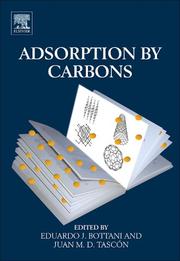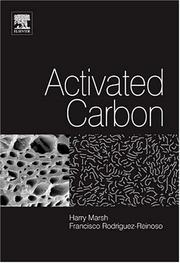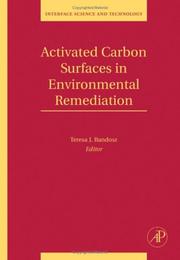| Listing 1 - 10 of 15 | << page >> |
Sort by
|
Book
Year: 1989 Publisher: Utrecht : Elinkwijk,
Abstract | Keywords | Export | Availability | Bookmark
 Loading...
Loading...Choose an application
- Reference Manager
- EndNote
- RefWorks (Direct export to RefWorks)
ACTIVATED CHARCOAL --- MASS TRANSFER --- DIFFUSION --- ACTIVATED CHARCOAL --- MASS TRANSFER --- DIFFUSION
Book
ISBN: 9781620816660 1620816660 9781612096841 1612096840 Year: 2012 Publisher: New York
Abstract | Keywords | Export | Availability | Bookmark
 Loading...
Loading...Choose an application
- Reference Manager
- EndNote
- RefWorks (Direct export to RefWorks)
Carbon, Activated. --- Activated carbon --- Activated charcoal --- Charcoal, Activated --- Adsorption --- Charcoal
Book
Year: 1977 Publisher: New York, NY : AIChE (American Institute of Chemical Engineers),
Abstract | Keywords | Export | Availability | Bookmark
 Loading...
Loading...Choose an application
- Reference Manager
- EndNote
- RefWorks (Direct export to RefWorks)
WATER --- WASTEWATER TREATMENT --- ACTIVATED CHARCOAL --- ION EXCHANGE --- ELECTROCHEMISTRY --- FREEZING --- OSMOSIS --- OZONIZATION --- WATER --- WASTEWATER TREATMENT --- ACTIVATED CHARCOAL --- ION EXCHANGE --- ELECTROCHEMISTRY --- FREEZING --- OSMOSIS --- OZONIZATION
Book
ISBN: 0824778421 9780824778422 Year: 1988 Publisher: New York (N.Y.): Dekker
Abstract | Keywords | Export | Availability | Bookmark
 Loading...
Loading...Choose an application
- Reference Manager
- EndNote
- RefWorks (Direct export to RefWorks)
Surface chemistry --- fysicochemie --- Carbon, Activated --- Activated carbon --- Activated charcoal --- Charcoal, Activated --- Adsorption --- Charcoal --- Porosity --- Surface

ISBN: 1281308544 9786611308544 0080559425 0080444644 9780080444642 9780080559421 9781281308542 Year: 2008 Publisher: Amsterdam London Elsevier
Abstract | Keywords | Export | Availability | Bookmark
 Loading...
Loading...Choose an application
- Reference Manager
- EndNote
- RefWorks (Direct export to RefWorks)
This book covers the most significant aspects of adsorption by carbons, attempting to fill the existing gap between the fields of adsorption and carbonaceous materials. Both basic and applied aspects are presented. The first section of the book introduces physical adsorption and carbonaceous materials, and is followed by a section concerning the fundamentals of adsorption by carbons. This leads to development of a series of theoretical concepts that serve as an introduction to the following section in which adsorption is mainly envisaged as a tool to characterize the porous texture and surface
Carbon --- Carbon, Activated. --- Absorption and adsorption. --- Activated carbon --- Activated charcoal --- Charcoal, Activated --- Adsorption --- Charcoal
Book
Year: 1980 Publisher: New York, NY : AIChE (American Institute of Chemical Engineers),
Abstract | Keywords | Export | Availability | Bookmark
 Loading...
Loading...Choose an application
- Reference Manager
- EndNote
- RefWorks (Direct export to RefWorks)
WATER POLLUTION --- ACTIVATED CHARCOAL --- WASTEWATER TREATMENT, OZONIZATION --- WASTEWATER TREATMENT --- PAPER --- WASTE HEAT
Book
ISBN: 953516127X 9535101978 Year: 2012 Publisher: IntechOpen
Abstract | Keywords | Export | Availability | Bookmark
 Loading...
Loading...Choose an application
- Reference Manager
- EndNote
- RefWorks (Direct export to RefWorks)
The present book discusses the principal lignocellulosic precursors used in the elaboration of activated carbons in different countries such as Asia, America, Europe and Africa; the different methods and experimental conditions employed in the synthesis of activated carbons, including one analysis of the principal stages of the preparation such as carbonization and activation (i.e., chemical or physical activation). Also, the recent and more specialized techniques used in the characterization of activated carbons are discussed in this book. For example, the techniques employed to determine textural parameters (mercury porosimetry and gas adsorption isotherms at 77 K) and different spectroscopies to determine chemical functionality (Raman, FT-IR, etc.) and other X-Ray techniques. Additionally, an overview of the application of activated carbons obtained from lignocellulosic precursors for wastewater treatment. Specifically, the analysis and discussion are focused on the advantages and capabilities of activated carbons for the removal of relevant toxic compounds and pollutants from water such as heavy metals, dyes, phenol, etc. Finally, the use of pyrolysis method for the valorization of two Mexican typical agricultural wastes (orange peel and pecan nut shell) for energy and carbon production is considered in this book.
Carbon, Activated. --- Activated carbon --- Activated charcoal --- Charcoal, Activated --- Adsorption --- Charcoal --- Engineering --- Physical Sciences --- Engineering and Technology --- Ecohydrology --- Environmental Engineering
Book
Abstract | Keywords | Export | Availability | Bookmark
 Loading...
Loading...Choose an application
- Reference Manager
- EndNote
- RefWorks (Direct export to RefWorks)

ISBN: 1280640952 9786610640959 0080455964 0080444636 0080440304 9780080444635 9780080455969 Year: 2006 Publisher: Amsterdam : Elsevier,
Abstract | Keywords | Export | Availability | Bookmark
 Loading...
Loading...Choose an application
- Reference Manager
- EndNote
- RefWorks (Direct export to RefWorks)
Recent years have seen an expansion in speciality uses of activated carbons including medicine, filtration, and the purification of liquids and gaseous media. Much of current research and information surrounding the nature and use of activated carbon is scattered throughout various literature, which has created the need for an up-to-date comprehensive and integrated review reference. In this book, special attention is paid to porosities in all forms of carbon, and to the modern-day materials which use activated carbons - including fibres, clothes, felts and monoliths. In addition, the use of a
Carbon, Activated. --- Carbon, Activated --- Chemical & Materials Engineering --- Engineering & Applied Sciences --- Chemical Engineering --- Inorganic compounds. --- Compounds, Inorganic --- Inorganic chemicals --- Activated carbon --- Activated charcoal --- Charcoal, Activated --- Chemicals --- Chemistry, Inorganic --- Adsorption --- Charcoal

ISBN: 1280641436 9786610641437 0080455956 0123705363 9780123705365 9780080455952 Year: 2006 Publisher: Amsterdam ; San Diego, Calif. : Elsevier,
Abstract | Keywords | Export | Availability | Bookmark
 Loading...
Loading...Choose an application
- Reference Manager
- EndNote
- RefWorks (Direct export to RefWorks)
Activated Carbon Surfaces in Environmental Remediation provides a comprehensive summary of the environmental applications of activated carbons. In order to understand the removal of contaminants and pollutants on activated carbons, the theoretical bases of adsorption phenomena are discussed. The effects of pore structure and surface chemistry are also addressed from both science and engineering perspectives. Each chapter provides examples of real applications with an emphasis on the role of the carbon surface in adsorption or reactive adsorption. The practical aspects addressed in t
Pollution --- Carbon, Activated. --- Carbon --- Environmental aspects. --- Group 14 elements --- Light elements --- Activated carbon --- Activated charcoal --- Charcoal, Activated --- Adsorption --- Charcoal --- Chemical pollution --- Chemicals --- Contamination of environment --- Environmental pollution --- Contamination (Technology) --- Asbestos abatement --- Bioremediation --- Environmental engineering --- Environmental quality --- Factory and trade waste --- Hazardous waste site remediation --- Hazardous wastes --- In situ remediation --- Lead abatement --- Pollutants --- Refuse and refuse disposal --- Environmental aspects
| Listing 1 - 10 of 15 | << page >> |
Sort by
|

 Search
Search Feedback
Feedback About UniCat
About UniCat  Help
Help News
News